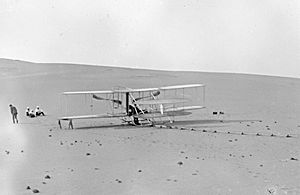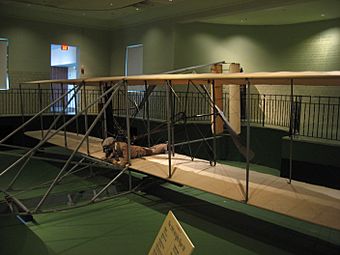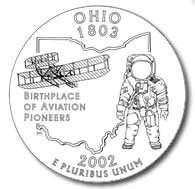Wright Flyer III facts for kids
The Wright Flyer III was the third airplane built by the Wright brothers. They built it during the winter of 1904–1905. Orville Wright made its first flight on June 23, 1905.
The Flyer III was made mostly of wood. Its wings had a special curve, like their first plane from 1903. The new plane used the engine and other parts from their old Flyer II. After they made many changes, the Flyer III flew much better than their first two planes, the Flyer I and Flyer II.
Quick facts for kids Wright Flyer III |
|
|---|---|
 |
|
| The Wright Flyer III over Huffman Prairie, October 4, 1905 during its 46th flight. The front of the airplane is at the top of the photo. | |
| Role | Experimental airplane |
| National origin | United States |
| Designer | Orville and Wilbur Wright |
| First flight | June 23, 1905 |
| Number built | 1 |
| Developed from | Wright Flyer II |
| Career | |
| Fate | Preserved |
| Preserved at | Dayton Aviation Heritage National Historical Park |
Contents
Making the Plane Better
When it was first built, the Flyer III looked a lot like the older planes. It also didn't fly much better. Orville had a small accident in the plane on July 14, 1905. He was not badly hurt.
When the Wrights rebuilt the airplane, they made some very important changes. These changes fixed the problems that the earlier planes had with staying steady in the air.
Key Improvements
The Wrights made the elevator (which controls up and down movement) and the rudder (which controls steering) almost twice as big. They also moved these parts farther away from the wings.
They added two fixed, half-moon shaped parts called "blinkers" between the elevators. (They later took these off.) They also made the landing skids wider. This helped the wings have a very slight upward angle, called a dihedral, which made the plane more stable.
The rudder on the rebuilt Flyer III was no longer connected to the wing-warping control. This meant the pilot could steer the plane with a separate handle, which was easier. They also put in a bigger fuel tank. Two radiators were added to cool the engine, so the plane could fly for longer times.
Successful Flights
When they started testing the Flyer III again in September, it was clear the changes worked. The plane no longer had problems staying steady in the air. Crashes, some of which had been serious before, stopped happening.
Flights with the new plane started lasting over 20 minutes. The Flyer III became a practical and reliable airplane. It could fly for a long time, bring its pilot back safely, and land without damage.
On October 5, 1905, Wilbur flew the plane for 24.2 miles (38.9 kilometres) in 39 minutes and 23 seconds. This was over Huffman Prairie. This single flight was longer than all their flights in 1903 and 1904 combined! A few days later, they offered to sell their new, practical airplane to the United States government.
Flying at Kill Devil Hills

To keep their ideas secret from other inventors, the Wrights stopped flying the Flyer III. They took the plane apart on November 7, 1905.
Two and a half years later, after getting contracts to sell their airplane, they fixed up the Flyer III. They added seats for a pilot and a passenger. They also put in new control levers and a more powerful engine. They sent the plane to North Carolina. From May 6 to 14, 1908, they practiced flying near Kill Devil Hills. They tested the new controls and how well the plane could carry a passenger.
First Airplane Passenger
On May 14, 1908, Wilbur flew with a mechanic named Charles Furnas. They flew 1,968 feet (600 metres) in 29 seconds. This made Charles Furnas the first airplane passenger! On the same day, Orville also flew with Furnas, going 2,125 feet (648 metres) in 4 minutes and 2 seconds.
Newspaper reporters saw Orville's flight with Furnas from a distance. They thought Wilbur and Orville were flying together. Charles Furnas is one of the few people who flew with both Wright brothers. Their sister, Katharine Wright, was another.
Later that day, Wilbur was flying alone. He accidentally moved a control lever the wrong way and crashed into the sand. He got some bruises. The front elevator of the Flyer was badly damaged. Because they had public flights coming up in France and Virginia, the Wrights did not fix the airplane. It never flew again after that crash.
Where is the Plane Now?
The Wright Flyer III was left damaged in its hangar in North Carolina. In 1911, a museum in Massachusetts got most of the parts from the abandoned Flyer. However, they never put the plane back together or showed it.
The parts of the 1905 airplane stayed in Massachusetts for almost 40 years. In 1946, Orville Wright asked for them back. He wanted the Flyer to be restored and shown at Edward A. Deeds' Carillon Historical Park in Dayton, Ohio. Some people from Kitty Hawk also had pieces of the plane. Deeds and Orville got many of these parts back for the restoration.
After the restoration was finished in 1950, experts believed that 60 to 85% of the plane was still original material. Today, the 1905 Wright Flyer III is on display at the Wright Brothers Aviation Center in Carillon Historical Park. This aircraft is the only fixed-wing airplane to be named a National Historic Landmark.
A Missing Piece Found

A small but important part of the Flyer III was missing for a long time. It was found in 2010 by a man named Palmer Wood. His uncle had given him the piece in the 1960s.
This missing piece is called an actuator. It connects the controls to the front elevator. In the 1940s, Orville had collected many stray pieces of the Flyer from people in Kitty Hawk. But this actuator piece, which likely broke off during Wilbur's crash in 1908, was missed. It had been replaced with a different part during the restoration. Finding the original piece helped make the restored Flyer III even more accurate to its 1905 design.
Specifications (Flyer III)
|
Wright Flyer III
|
|

Flyer III in the museum
|
|
| Location | Dayton, Ohio |
|---|---|
| Built | 1905 |
| Architect | Orville and Wilbur Wright |
| NRHP reference No. | 90001747 |
| Added to NRHP | June 21, 1990 |

Data from Sharpe, 2000. p 311.
General characteristics
- Crew: one pilot
- Length: 28 ft 0 in (8.53 m)
- Wingspan: 40 ft 4 in (12.29 m)
- Height: 8 ft 0 in (2.44 m)
- Wing area: 503 sq ft (46.7 m2)
- Gross weight: 710 lb (322 kg)
- Max takeoff weight: 710 lb (322 kg)
- Powerplant: 1 × Wrights' water-cooled, 4-cylinder, inline engine, 20 hp (15 kW)
Performance
- Maximum speed: 35 mph (56 km/h; 30 kn)
- Range: 25 mi (22 nmi; 40 km) as of October 1905
- Service ceiling: 50 to 100 ft (15 to 30 m) as of October 1905
- Wing loading: 1.4 lb/sq ft (6.8 kg/m2)
- Power/mass: 0.03 hp/lb (0.05 kW/kg)
See also
 In Spanish: Wright Flyer III para niños
In Spanish: Wright Flyer III para niños



